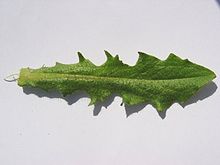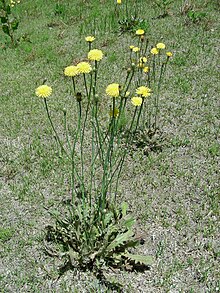Common piglet weed
| Common piglet weed | ||||||||||||
|---|---|---|---|---|---|---|---|---|---|---|---|---|

Common piglet weed ( Hypochaeris radicata ) |
||||||||||||
| Systematics | ||||||||||||
|
||||||||||||
| Scientific name | ||||||||||||
| Hypochaeris radicata | ||||||||||||
| L. |
The common piglet herb ( Hypochaeris radicata ) is a species of the sunflower family (Asteraceae). It is common in large parts of the northern hemisphere .
description
The common piglet grows as a perennial herbaceous plant and reaches heights of 20 to 70 centimeters. Its basal and unspotted leaves are scattered with hairy bristles. The blue-green, mostly branched, stem bears several flower heads, is stiff-haired at the bottom, but bare at the top and has at most a few scaly bracts .
The flowering period extends from June to October. The basket shell is about 15 to 25 millimeters high. The basket bottom has chaff leaves . The flower head contains only ray-flowers . The yellow petals are longer than the shell. All developed fruits - in this case achenes - have long beaks. In the double-row pappus , only the inner row is feathered.
The number of chromosomes is 2n = 8.
ecology
The common pigweed is a short-lived rosette hemicryptophyte . It is a deep-rooted species with a short rhizome and survives the winter thanks to its taproot.
The mown inflorescences are quickly replaced by new, regrowing inflorescences. The golden yellow "cup flowers" are only open on sunny days in the mornings and have up to 100 ray florets. Pollinators are a variety of insects , especially bees .
The achenes with their feathered pappus are spread out by the wind.
Occurrence
It occurs all over the northern hemisphere, in Eurasia and in parts of the New World. It is native to Europe, North Africa, the Canary Islands, Madeira, Western Asia and the Caucasus. It is a neophyte in southern Africa, Madagascar, Mauritius and the Azores, India, Japan, Taiwan and Yunnan, in North and South America, in Australia, New Zealand and Hawaii.
The common piglet herb is widespread in all of Germany up to montane altitudes as well as in the rest of Europe. It rises in the Allgäu Alps southwest of the Weiherkopf near Bolsterlang in Bavaria up to 1535 m above sea level. It grows on dry meadows, semi- arid grass or on the edges of forests. It grows in societies of the associations Cynosurion, Arrhenatherion, Molinion, Violion or the class Sedo-Scleranthetea. The common piglet grows on fresh to moderately dry, moderately nutrient-rich and base-rich, low-lime or decalcified, neutral to acid, musty-humic or raw, preferably sandy loam and clay soils in mild, humid climates.
Taxonomy and systematics
The first publication of Hypochaeris radicata was in 1753 by Carl von Linné in Species Plantarum . Synonyms for Hypochaeris radicata L. are Porcellites radicata (L.) Cass. , Hypochaeris neapolitana DC. , Seriola caespitosa Porta and Hypochaeris radicata subsp. neapolitana (DC.) Nyman .
One can distinguish the following subspecies:
- Hypochaeris radicata subsp. ericetorum Soest (Syn .: Hypochaeris salina Gren. ): It occurs in Great Britain, France and Belgium.
- Hypochaeris radicata subsp. platylepis (Boiss.) Yahand. & Maire (Syn .: Hypochaeris platylepis Boiss. ): It occurs in Portugal, Spain, Morocco, Algeria, Tunisia, Sicily, Sardinia, Italy, Albania and Greece.
- Hypochaeris radicata subsp. radicata .
supporting documents
literature
- Siegmund Seybold (Ed.): Schmeil-Fitschen interactive . CD-ROM, version 1.1. Quelle & Meyer, Wiebelsheim 2002, ISBN 3-494-01327-6 .
- Ruprecht Düll , Herfried Kutzelnigg : Pocket dictionary of plants in Germany and neighboring countries. The most common Central European species in portrait . 7th, corrected and enlarged edition. Quelle & Meyer, Wiebelsheim 2011, ISBN 978-3-494-01424-1 , p. 449 .
Individual evidence
- ↑ a b c Erich Oberdorfer : Plant-sociological excursion flora for Germany and neighboring areas . With the collaboration of Angelika Schwabe and Theo Müller. 8th, heavily revised and expanded edition. Eugen Ulmer, Stuttgart (Hohenheim) 2001, ISBN 3-8001-3131-5 , pp. 977 .
- ^ Roy Turkington, Lonnie W. Aarssen: Biological Flora of the British Isles. Hypochoeris radicata L. (Achyrophorus radicatus (L.) Scop.). In: Journal of Ecology. Volume 71, No. 3, 1983, pp. 999-1022, JSTOR 2259607 .
- ^ A b Hypochaeris radicata in the Germplasm Resources Information Network (GRIN), USDA , ARS , National Genetic Resources Program. National Germplasm Resources Laboratory, Beltsville, Maryland. Retrieved June 25, 2016.
- ↑ Erhard Dörr, Wolfgang Lippert : Flora of the Allgäu and its surroundings. Volume 2, IHW, Eching 2004, ISBN 3-930167-61-1 , p. 657.
- ↑ Carl von Linné: Species Plantarum. Volume 2, Lars Salvius, Stockholm 1753, p. 811, digitized .
- ↑ a b c d Werner Greuter (2006+): Compositae (pro parte majore). - In: W. Greuter & E. von Raab-Straube (ed.): Compositae. Euro + Med Plantbase - the information resource for Euro-Mediterranean plant diversity. Datasheet Hypochaeris radicata In: Euro + Med Plantbase - the information resource for Euro-Mediterranean plant diversity.
Web links
- Common piglet weed. In: FloraWeb.de.
- Common piglet weed . In: BiolFlor, the database of biological-ecological characteristics of the flora of Germany.
- Profile and distribution map for Bavaria . In: Botanical Information Hub of Bavaria .
- Hypochaeris radicata L. In: Info Flora , the national data and information center for Swiss flora .
- Distribution in the northern hemisphere from: Eric Hultén, Magnus Fries: Atlas of North European vascular plants. 1986, ISBN 3-87429-263-0 at Den virtuella floran. (Swedish)
- Thomas Meyer: Ferkelkraut data sheet with identification key and photos at Flora-de: Flora von Deutschland (old name of the website: Flowers in Swabia )
- Pictures, University of Leuven



